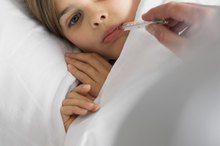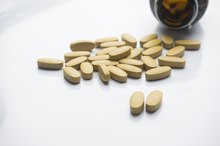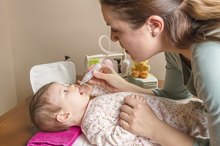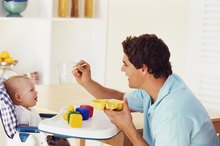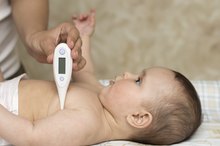What Foods Can Be Offered to Babies With a Fever?
A fever is the most common reason why parents contact their child's pediatrician, according to Senders Pediatrics 1. If your baby develops an elevated temperature, it's natural to want to do whatever you can to help her feel better. By choosing the best foods to feed your baby when she has a fever, you can make her more comfortable and speed her recovery.
Baby Fevers
The normal temperature for a baby is between 97 and 100.4 degrees Fahrenheit, according to BabyCenter.com 2. A rectal temperature higher than this indicates your baby has developed a fever. In many cases, it's fine to let your baby's fever run its course because a fever just indicates that his body is fighting off an infection. However, the American Academy of Pediatrics recommends that you contact your baby's pediatrician if he's under 3 months and his rectal temperature is 100.4 degrees F or more, if he's between 3 and 6 months with a temperature of 101 degrees F or more, or if he's over 6 months with a temperature of 103 degrees F or more -- especially if you notice a change in his activity level.
- The normal temperature for a baby is between 97 and 100.4 degrees Fahrenheit, according to BabyCenter.com 2.
- However, the American Academy of Pediatrics recommends that you contact your baby's pediatrician if he's under 3 months and his rectal temperature is 100.4 degrees F or more, if he's between 3 and 6 months with a temperature of 101 degrees F or more, or if he's over 6 months with a temperature of 103 degrees F or more -- especially if you notice a change in his activity level.
Foods for a Fever
4-Month-Baby Diet
Learn More
Feed your feverish baby as much breast milk or formula -- her primary food during her first year -- as she wants. This will help keep her from becoming dehydrated and provide her with nutrients that she needs. Breast milk in particular benefits your baby since it contains antibodies, it's easy to digest and the act of nursing comforts her. If your baby has started solid foods, offer her other age-appropriate solids that have a high-liquid content, such as soups, flavored gelatin or frozen juice Popsicles.
- Feed your feverish baby as much breast milk or formula -- her primary food during her first year -- as she wants.
- If your baby has started solid foods, offer her other age-appropriate solids that have a high-liquid content, such as soups, flavored gelatin or frozen juice Popsicles.
Decreased Appetite
Convincing a baby with a fever to eat can be difficult, especially if he has a fever high enough to warrant a call to his pediatrician 3. A high fever may make your baby feel so miserable that he doesn't want to eat. However, it's important for him to at least taken in some high-liquid foods, since he needs energy to fight the infection and enough fluids to prevent dehydration. Consuming cool liquids can also help make him feel more comfortable by lowering his body temperature naturally.
- Convincing a baby with a fever to eat can be difficult, especially if he has a fever high enough to warrant a call to his pediatrician 3.
Recommendations
My Baby's Fever Comes & Goes
Learn More
Follow your baby's lead in determining what to feed her. If she doesn't have much of an appetite, let her eat the foods she wants to -- even if this means that she goes back to just eating breast milk or formula until her fever is gone. Don't force her to eat if she isn't hungry. Babies eat when they need to, and her appetite will come back when she's feeling better. However, if your baby won't eat any breast milk or formula at all, contact her pediatrician, because refusing to eat is a sign of a more serious fever.
- Follow your baby's lead in determining what to feed her.
- Don't force her to eat if she isn't hungry.
Related Articles
References
- Senders Pediatrics: Fever
- BabyCenter: Fever
- HealthyChildren: When to Call the Pediatrician
- What to Expect: Feeding a Sick Baby
- FamilyDoctor: Fever in Infants and Children
- Sullivan JE, Farrar HC. Fever and antipyretic use in children. Pediatrics. 2011;127(3):580-7. doi:10.1542/peds.2010-3852
- Chapman J, Arnold JK. Reye syndrome. In: StatPearls. Updated January 17, 2019.
- El-Radhi AS. Fever management: evidence vs current practice. World J Clin Pediatr. 2012;1(4):29-33. doi:10.5409/wjcp.v1.i4.29
- Walter EJ, Hanna-Jumma S, Carraretto M, Forni L. The pathophysiological basis and consequences of fever. Crit Care. 2016 Jul 14;20(1):200. doi:10.1186/s13054-016-1375-5
- American Academy of Pediatrics. Fever without fear: Information for Parents. Updated April 22, 2016.
- MedlinePlus. Fever. Updated February 13, 2020.
- Cleveland Clinic. Fever: Care and treatment. Updated December 31, 2019.
- American College of Cardiology. Sponge bath for a child's fever. Updated September 13, 2012.
- Cleveland Clinic. Fever. Updated December 31, 2019.
- American Academy of Pediatrics. Fever and pain medicine: How much to give your child. Updated April 6, 2016.
- National Organization for Rare Disorders. Reye syndrome. 2017.
- MedlinePlus. Acetaminophen. Updated February 18, 2020.
- National Center for Complementary and Integrative Health. Feverfew. Updated November 30, 2016.
- Cleveland Clinic. Fever: When to call the doctor. Updated December 31, 2019.
Writer Bio
Based in southern Idaho, Michelle Johnson started writing in 1991. Her work has been published in the science fiction and fantasy journal, "Extrapolation." Johnson holds a Bachelor of Arts in creative writing and a Master of Arts in fantasy literature, both from Hofstra University in New York.


